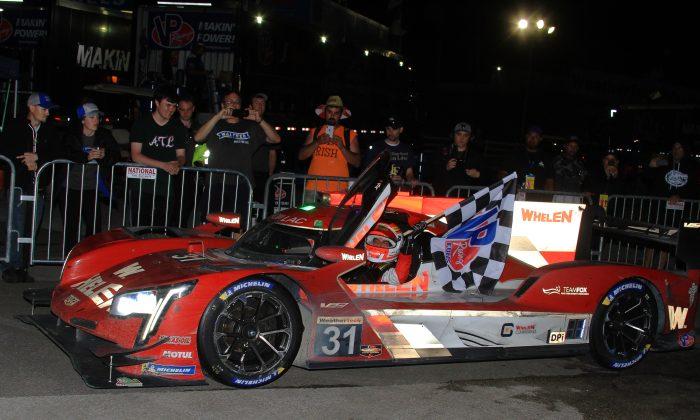Katusha’s Luca Paolini snatched victory in Stage Three of the 2013 Giro d’Italia with a bold attack in the last 6.5 kilometers of the 222-km stage, crossing the finish line 16 seconds ahead of the favorites. With the time bonus, he also claimed the race leader’s pink jersey, the maglia rosa.
Paolini’s Katusha team mates wisely charged forward when a group off General Classification contenders broke free of the peloton in the in pursuit of 2012 winner Ryder Hesjedal, who unexpectedly—and repeatedly—attacked on the final climb and descent of the stage. Paolini took advantage of his team mates’ efforts by attacking at the bottom of the descent, when the GC contenders had used up their energy chasing Hesjedal, who also eased his pace, having not gained a gap.
Ironically, Paolini nearly didn’t make it to the Giro. Katusha got involved in controversy with the International Cycliasts’ Union (UCI) which administers professional cycling. Because the Russian team had two riders test positive for drugs (one in 2011, one in 2013) one of which was also implicated in a bribery scheme, the UCI denied them a World Tour license, despite the team finishing second in points in 2012.
Katusha appealed to the Court for Sports Arbitration (CAS) and won a last-minute wild-card invitation to the race. Obviously the team wants to prove it deserves the honor.
Paolini will start Stage Four in pink, and might hold the jersey for a few stages; if the other GC-seeking teams decide not to chase the jersey. Often the top GC teams won’t chase the leader’s jersey early in a race, because the effort involved in defending the jersey wastes energy the teams might need later.
However, Stage Four is also a good stage for a rider like Ryder Hesjedal, who has shown he want to be aggressive, to try to steal a few more seconds on his GC rivals. Like Stage Three, Stage Four ends with a pair of climbs. The difference is that Stage Four has a Cat 3 followed by a Cat 2 followed by an uphill finish. A rider could attack on the final climb or on the descent, or even wait until the last hill to make a move and gain a small gap which might be important later in the race.
Hesjedal Defends His 2012 Win
The race started with seven riders: Fabio Taborre (Vini Fantini-Selle Italia,) Manuele Boaro (Saxo-Tinkoff,) Willem Wauters (Vacansoleil-DCM,) Jarlinson Pantano (Colombia,) Bert De Backer (Argos-Shimano,) Dirk Bellemakers (Lotto Belisol,) and Jackson Rodriguez (Androni Giocattoli) attacking immediately. The peloton let them get a seven-minute gap on the first of the day’s categorized climbs, the Cat 2 San Mauro Cilento before shutting them down on the Cat 3 Sella di Catona.
The narrow, twisty descent from Sella di Catona was perfect for a really skilled descender to gain time, but also a prime place for crashes. Rain before the race added apprehension, but luckily the weather changed and the roads dried before the riders arrived.
Even though the roads were dry, they claimed one victim. Lampre’s GC rider Michele Scarponi crashed while chasing a pair of Blanco riders who were chasing Paolini at the very bottom of the descent.
2012 winner Ryder Hesjedal of American team Garmin-Sharp made the race exciting by repeatedly attacking on this descent.
In this age of race radios and computer-calculated strategies where riders pace themselves according to power meters, Hesjedal just went for it repeatedly. This was not youthful enthusiasm—Hesjedal, a Canadian, is 32—but it was unexpected, and possibly not a great tactic. With 18 stages yet to ride, it was a bit early to be burning energy and taking risks on a technical descent.
On the other hand, Astana’s Vincenzo Nibali, a fantastic descender, was expected to attack in the final 25-km run from the last peak to the finish to try to gain some seconds on his General Classification rivals. Hesjedal’s maneuvers quashed any attempts Nibali might have made
Hesjedal’s attacks had another consequence. No one was sure how the stage would end: a sprint, a breakaway, Nibali escaping on the descent? Hesjedal’s aggressiveness shelled off the sprinters, muted Nibali, and ensured that none of the GC contenders would be able to relax.
Hesjedal ended up third, finishing behind 2011 Tour de France winner Cadel Evans of BMC. These two gained a few bonus seconds which might be important later in the race.
Will Wiggins Win?
Bradley Wiggins had a career year in 2012, winning the Tour de France and the Olympics and just about every other race he entered. His Sky squad is in the enviable position of having so many great riders the team cannot decide on a race leader for the Tour de France—Chris Froome was nominated but Wiggins says he might be interested.
Wiggins finished eight, at the same time as the other GC contenders, but missed out on the bonus seconds.
Wiggins is a good climber and a great time trailer, and this Giro’s parcours suits him, with a pair of solo stages, one of 55 km. Perhaps he isn’t worried about losing a few seconds here and there, thinking he can make it up in the time trial and mountain stages. Sky certainly has the strongest lineup and should be fastest up the hills, and Wiggins is an amazing time trailer, which might be why Hesjedal is so eager to put pressure on his rival.





